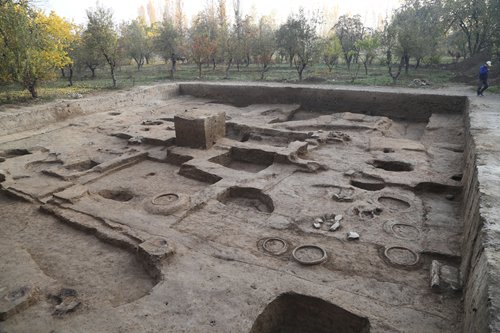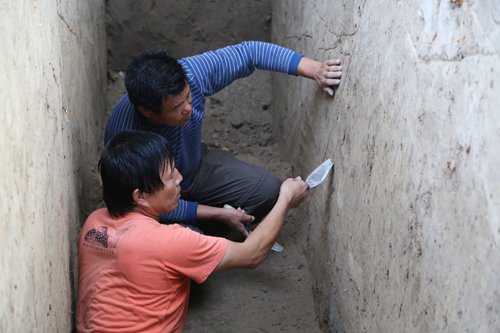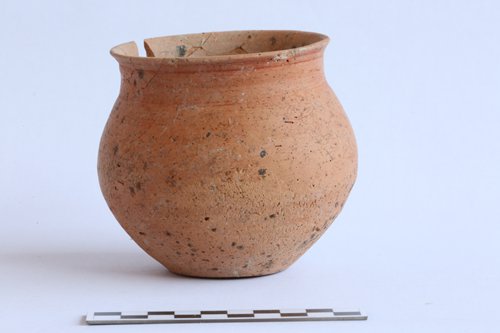DepthReading
Chinese head of Uzbekistan Mingtepa excavation project discusses China’s archaeological teams working abroad

Remains of the Mingtepa workshops Photo: Courtesy of the Central Asian Archaeological Team belonging to the CASS Institute of Archaeology

Two excavators work to unearth a city wall at the Mingtepa site in Uzbekistan. Photo: Courtesy of the Central Asian Archaeological Team belonging to the CASS Institute of Archaeology

Pottery jar discovered at the Mingtepa site Photo: Courtesy of the Central Asian Archaeological Team belonging to the CASS Institute of Archaeology
In the southeastern part of the Ferghana Valley in Uzbekistan - once the site of the ancient kingdom known in Chinese as Dayuan - Chinese and Uzbekistan archaeologists are busily working together to dig up the secrets hidden beneath the ruins of the ancient city of Mingtepa.
Over the past five years, the joint archaeological team has made a number of major discoveries, including the discovery of the outer-city walls and the remains of the inner city's road system and workshops. These discoveries have revealed that "Mingtepa was not simply a provisional garrison fort for nomads, but a fully functional castle, the largest in the Ferghana Valley" over 2,000 years ago, according to a Xinhua News Agency report on January 10.
Although this is not China's only joint archaeological excavation project being carried out overseas, the project, started in 2012, is the first overseas joint excavation project led by national-level institutions.
Establishing a bond
"Many people asked me if this project was started due to the 'Belt and Road' initiative. The answer is 'no,'" Zhu Yanshi, director of the Department of Han to Tang Studies at the Institute of Archaeology under the China Academy of Social Sciences (CASS) and the project's Chinese team leader, told the Global Times on March 24. "It's just a coincidence."
According to Zhu, exploration of historical sites along the ancient Silk Road has always been a major focus for Chinese archaeology. The Mingtepa project in particular got its start in 2010 when Wang Wei, former head of the CASS Institute of Archaeology, brought up the subject of the ancient city during a trip to the Archaeology Institute under the Academy of Sciences of Uzbekistan. This was three years before Chinese President Xi Jinping first proposed the "Belt and Road" initiative in 2013. The two institutes signed an official agreement in 2011 and began excavation efforts the very next year.
Though the Mingtepa project wasn't initiated as part of the "Belt and Road" initiative, the Chinese government regards the project as the perfect example of how Chinese archaeology is now playing "an increasingly important role in China's cultural diplomacy," Zhu noted.
Apart from the Mingtepa project, an increasing number of archaeological teams from China have been participating in joint excavation projects overseas over the past decade. These projects range from a dig in Copán, a Mayan archaeological site in western Honduras, to the Precinct of Montu, a part of the ruins of the Karnak temple complex in southern Egypt, and key sites at Sarnath in northeast India, the place where the Buddha gave his first sermon.
Zhu explained that this trend is the result of China's increasing economic strength and the country's archeological circle's growing interest in conducting exchanges with their foreign counterparts.
Working in Uzbekistan
Zhu pointed out that as one of the ancient foreign city ruins bordering Chinese territory, Mingtepa is an ideal place to study the integration of ancient Chinese and Western cultures.
It is also a great opportunity for contemporary cultural exchange.
"We hope the excavation can help resolve some of the key issues involving Silk Road studies from the Han (206BC-AD220) to the Jin (265-420) dynasties. We also want to introduce Chinese archaeological methods and technology to our Uzbekistan counterparts, which we feel will not only assist the excavation, but more importantly, help locals preserve and display any discovered relics," Zhu said.
Aside from the circular-shaped Luoyang shovel, a traditional Chinese archaeological tool that allows excavators to probe the soil without having to dig large pits, more modern means such as 3D modeling, laser mapping and cloud computing technology were used by the Chinese team during the excavation, and were soon embraced by their Uzbekistan counterparts.
According to Zhu, cooperation between the team members has gone well despite differences in language and the way they work.
"For instance, when we first started working together, we disagreed on how to implement a labeling system," Zhu recalled. While Chinese team members were used to labeling relics according to their Chinese names, the Uzbekistan experts preferred using Uzbek names.
"At the end, we accepted a part of their labeling system and they accepted a part of ours," Zhu said. "It's all about communication and mutual respect."
The heads of the institutes of both countries act as team leaders on the project. Team leader Zhu and his team of five experts and 10 technicians have worked in Uzbekistan for two months in the late summer every year since 2012, and will most likely continue to do so for the next three years in order to continue to explore the areas between the interior and exterior walls of the city.
Facing the occasional breakdown of their heating system, difficult weather conditions and food that is foreign to them, the Chinese archaeological team has had a tough time adapting to local life. However, thanks to their Uzbekistan colleagues and friends, they have begun feeling more at home in the Central Asian country.
"Local residents have made nang [a local sesame seed cake] for us, invited us to their weddings and greeted us by saying 'ni hao [hello],'" Zhu smiled.
"In return, we bring Chinese tea and candy as gifts and sometimes invite local middle school students to visit the site."
Category: English
DepthReading
Key words:
